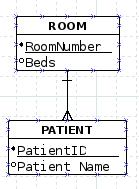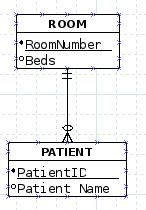The Entity-Relationship Model
- An entity is a group of objects with the same properties, which are identified by the enterprise as having an independent existence.
- In part 1 of homework 4,
- A PATIENT is an entity
- A DRUG is an entity
- A PRESCRIPTION is an entity
- A ROOM might be an entity.
- An ADMITTANCE might be an entity.
- These seem to be referred to as entity classes or entity types in different books.
- A entity instance or occurrence
- This is an uniquely identifiable object of an entity type.
- Bob Smith, Number 100-111 is an instance of a patient.
- P100 Morphine is an instance of a drug.
- Entities have attributes
- Attributes are properties of an entity or relationship.
- Attributes describe the characteristics of an entity.
- Attributes are simple (composed of a single component)
- Or composition (composed of multiple components)
- Identifiers are attributes that name, or identify entity instances
- We have been calling these candidate keys in database terms.
- A relationship is a meaningful association among entity types.
- A relationship type is a collection of relationship
- A relationship occurrence is an instance.
- Relationships can be named
- The degree of a relationship shows the number of entities involved in the relationship.
- Two is a binary relationship
- Three is a ternary relationship.
- We will decompose non-binary relationships into binary relationships.
- The cardinality of a relationship describes how many instances of one entity can participate in the relationship.
- This is counted for both entity classes involved in the relationship.
- A cardinality of 1:1 (one to one) means that one instance of each entity
- For example, a patient has a one to one relationship with a bed
- A cardinality of 1 to many means (1:N)that one instance of the first entity can be associated with many instances of the second entity
- For example, A patient may have many prescriptions. (But somehow the prescriptions are unique to a patient)
- A cardinality of many-to many (N:M) that each entity may be associated with multiples of the other.
- In our example, the patient drug relationship is many to many
- A patient may be prescribed many drugs.
- A drug may be prescribed to many patients.
- Relationships can also be classified as optional or mandatory
- In our model, A patient must have a bed, but we can have beds without patients. so this is Optional to Mandatory.
- A patient may or may not have a drug prescribed to them, and a drug may or not be prescribed to a patient.
- I can't think of a MANDATORY to MANDATORY relationship in our example.
- ER diagrams give us a way to indicate entities and relationships pictorially
- Entities are drawn as boxes, with the Entity name at the top.
-

- Relationships are indicated by lines.
- The marks at the end of the lines indicate the maximum cardinality
-

- Here a room may be assigned to many patients, but a patient must be assigned to one room.
- MANDATORY and Optional are also represented on these lines.
-

- Here a patient MUST be assigned to a room, but a room might not have any assigned patients.
- This is called the crow's foot model.
- Strong and Weak entities
- A strong entity is an entity that can exist on it's own.
- A person is a strong entity.
- A weak entity is an entity that is existence dependent on some other entity
- A prescription can not exist without out a drug.
- A prescription can not exist without a person.
- ID-Dependent Entities
- An entity is ID Dependent if the entity's identifier includes the identifier of another entity.
- If we added a BED entity to our model.
- An entity in BED would need both the bed number and the room number.
- This is an example of an ID-Dependent entity.


